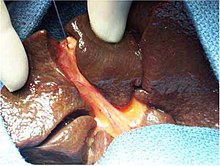User:Mr. Ibrahem/Biliary atresia
| Extrahepatic biliary atresia | |
|---|---|
| Other names | Extrahepatic ductopenia, progressive obliterative cholangiopathy |
 | |
| Intraoperative view of complete extrahepatic biliary atresia[1] | |
| Specialty | General surgery |
| Symptoms | Yellowish skin, clay colored stool, enlargment of the liver[2] |
| Complications | Malnutrition, cirrhosis, liver failure[3] |
| Usual onset | First few months of life[4] |
| Types | I, IIa, IIb, III[2] |
| Causes | Unknown[2] |
| Diagnostic method | Suspected based on blood tests and medical imaging, confirmed by liver biopsy or cholangiography[4][2] |
| Differential diagnosis | Alagille syndrome, alpha-1-antitrypsin deficiency[4] |
| Treatment | Surgery[2] |
| Frequency | 1 in 15,000 newborns (Europe, N. America)[4] |
Biliary atresia is a disease that results in a progressive breakdown of the bile ducts both inside and outside the liver.[5][2] Onset of symptoms is generally in the first few months of life with yellowish skin, grey colored stool, and enlargment of the liver.[2][4] Complications can include malnutrition, cirrhosis, and liver failure.[3]
The cause is frequently unknown.[2] Occasionally it may occur along with other birth defects, known as embryonic biliary atresia.[3] The underlying mechanism involves inflammation of the bile ducts.[4] Diagnosis may be suspected based on blood tests and medical imaging with confirmation by liver biopsy or cholangiography.[4][2]
The only effective treatments is surgery.[2] Option may include the Kasai procedure or liver transplantation.[2] Without surgery survival beyond 3 years is less than 10%.[2] Long term survival with a person's own liver is about 25% despite surgery.[4]
Biliary atresia occurs in about 1 in 15,000 newborns in Europe and North America.[4][3] It is more common in Asia, with about 1 in 2,700 affected in Taiwan.[6] The condition was first described in 1817 by John Burns.[2] The current surgical technique came about in the 1950s.[2]
References[edit]
- ^ Chardot, Christophe (2006). "Biliary atresia". Orphanet Journal of Rare Diseases. 1: 28. doi:10.1186/1750-1172-1-28. PMC 1560371. PMID 16872500.
{{cite journal}}: CS1 maint: unflagged free DOI (link) - ^ a b c d e f g h i j k l m n Siddiqui, AI; Ahmad, T (January 2020). "Biliary Atresia". PMID 30725947.
{{cite journal}}: Cite journal requires|journal=(help) - ^ a b c d "Definition & Facts of Biliary Atresia | NIDDK". National Institute of Diabetes and Digestive and Kidney Diseases. Archived from the original on 17 January 2021. Retrieved 13 February 2021.
- ^ a b c d e f g h i "Orphanet: Isolated biliary atresia". www.orpha.net. Archived from the original on 18 September 2020. Retrieved 13 February 2021.
- ^ "Biliary atresia | Genetic and Rare Diseases Information Center (GARD) – an NCATS Program". rarediseases.info.nih.gov. Archived from the original on 19 March 2021. Retrieved 13 February 2021.
- ^ Carroll, Will (2016). Surgery, Orthopaedics, Connective Tissue & Bone E-Book: Prepare for the MRCPCH. Key Articles from the Paediatrics & Child Health journal. Elsevier Health Sciences. p. PT62. ISBN 978-0-7020-7089-1. Archived from the original on 2021-08-28. Retrieved 2021-02-13.
